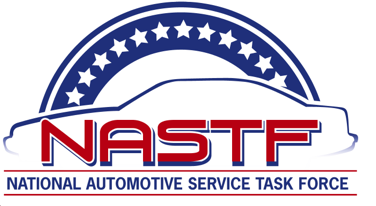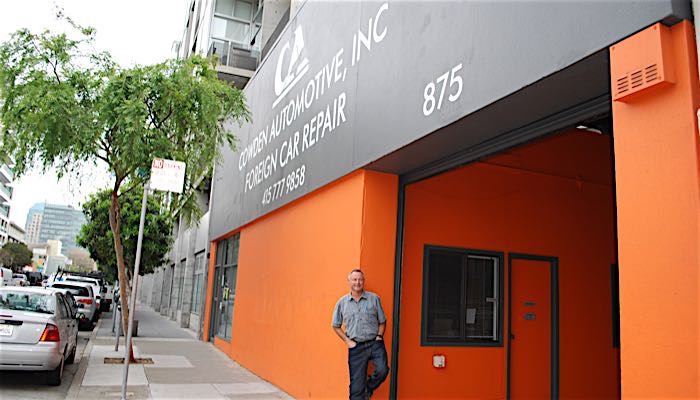 The Fall 2013 General Meeting of the National Automotive Service Task Force (NASTF) was held during the AAPEX/SEMA trade shows in Las Vegas on Wednesday, Nov. 6, 2013. Sixty-five people attended the event live, and another 37 attended via the webcast. More than 300 viewed the recorded webcast within a week following the event.
The Fall 2013 General Meeting of the National Automotive Service Task Force (NASTF) was held during the AAPEX/SEMA trade shows in Las Vegas on Wednesday, Nov. 6, 2013. Sixty-five people attended the event live, and another 37 attended via the webcast. More than 300 viewed the recorded webcast within a week following the event.
Ten volunteers presented topics recently raised by the NASTF board of directors and committees, covering issues concerning scan tools, collision repair and consumers.
Bob Stewart, manager of aftermarket service support for General Motors, addressed counterfeit scan tools in his presentation, "Who’s Cheating Whom."
“You wouldn’t trust another shop’s diagnosis without doing your own. Why would you trust a cheap counterfeit tool?” asked Stewart. "Counterfeit tools are copies made with intent to defraud the buyer and come with several risks: misdiagnosis, quality, safety, warranty, support and full loss of the purchase price when the tool fails." In a picture, Stewart revealed the internal components of a counterfeit Tech2 GM recently recovered. On the counterfeit circuit board, several pinholes had not been soldered, brand and part number identification had been scraped from all the integrated circuit modules and a jumper wire was soldered across one circuit to enable its operation.
“Counterfeit enforcement in some countries can be very difficult, so our best hope is to drive them out of the scan tool market by reducing demand,” said Stewart. “We can do that by educating you, the customer.” In closing, his warning to technicians was: “If the deal is too good to be true, it probably is.”
Greg Brannon, director of automotive engineering and industry relations for the American Automobile Association (AAA), introduced the consumer’s perspective in development of the connected car. He summarized consumer interest into three areas:
• Safety – to reduce crashes and improve traffic efficiency.
• Convenience and Piece of Mind – Including navigation, remote start, automated tolling, remote diagnosis and remote prognosis.
• Infotainment – This is an area where AAA sees severe cognitive distractions.
“Recent research is showing us that speech-to-text applications are among the most mentally distracting in the connected car,” said Brannon.
AAA represents the interest of their members – the vehicle owners – and believes the choice for their vehicle’s data belongs to them, the car owner. “Their choice applies to what, when, where, why, who and how,” he concluded.
Jason Bartanen, director of industry technical relations for I-CAR, kicked off a two-part presentation covering collision repair industry topics. Bartanen noted that the I-CAR Repairability Technical Support initiative has set out to establish direct links to OEM collision repair procedures on the OEM websites and that they intend to work with NASTF to avoid duplication of effort.
Leo Gruzas, manager of GM Service Engineering, was called upon by the NASTF Collision Committee leadership to describe key elements of the GM technical support website for collision technicians, a website they acclaimed as an example of a user-friendly resource. Gruzas introduced the website, www.GenuineGMParts.com, which is offered as an information-rich website without the need for a paid subscription. The key sections of the website include: Repair Procedures, Material Types, Service Bulletins, Paint Shop Information, Brochures & Sell Sheets, Warranty Information, Position Statements (including recommendations and testing information) and a VIN information map.
Donny Seyfer, owner of Seyfer Automotive and co-chair of the Equipment and Tool Committee (ETC), announced development of the “OEM Scan Tool Resource Center,” a cooperative project of the NASTF Service Information Committee and the Mechanical Operations Committee of the Automotive Service Association (ASA). Seyfer showed examples of the information that will be included for each OEM scan tool displayed from both the NASTF and ASA websites. He explained that the intention of the project is to provide buyers with comprehensive information in a similar format, which should simplify the decision process in evaluating the purchase of an OEM scan tool. He concluded by predicting release of the Resource Center near the end of 2013.
Claude Hensley, owner of Lockman Locksmiths and co-chair of the Vehicle Security Committee (VSC), reported on the Oct. 23 conference call meeting of the VSC. He noted that while the number of locksmiths subscribing to the NASTF Vehicle Security Professional Registry continues to grow, the higher growth rate from the auto technician subscribers has now trimmed the share of locksmiths in the registry to 55 percent with auto techs now representing 45 percent of subscribers. In another element of the VSC report, Hensley revealed that the National Insurance Crime Bureau (NICB) has processed 493,168 vehicle theft reports through Sept. 30, 2013, with only 18 percent found related to the 1.7 million NASTF VSP and car dealer transactions being tracked in the NASTF system in that time. Far fewer reports are actual thefts.
In 2013, NASTF has suspended three VSPs based on information received from NICB relating to auto thefts. NASTF, however, has stepped up enforcement of the accountability rules in the VSP Registry subscription. So far in 2013, six VSP Registry subscribers have been suspended for failure to comply with the VSP’s Terms and Conditions Agreement regarding positive ID of the vehicle owner. A total of only 12 were suspended in the previous four years for violation of that agreement.
Steve Douglas, director of environmental affairs for the Alliance of Automobile Manufacturers and Dave Zwalina, owner of Automotive One, each co-chairs of the NASTF Service Information Committee (SIC), summarized the current environment regarding OEM service information. “We’ve tried to level the playing field, and we are now pretty close,” said Douglas of the NASTF SIC efforts since formation in the year 2000. However, Zwalina voiced his concern that the average of only 60 SIRs (Service Information Requests) filed on average annually by independent technicians is not representative of the level of trouble that still exists.
“NASTF is the only open forum (between independent techs and the OEMs) available,” Zwalina remarked. “And there is a dialogue within NASTF (staff and volunteers) that really can solve these SIRs.” Douglas added, “If you think something is not right, let us know. File an SIR.”
Greg Potter, director of automotive and heavy-duty markets for DG Technologies and co-chair of the Equipment and Tool Committee (ETC), reported on an initiative to eliminate the current NASTF toolmaker’s (data availability) matrix.
“The problem with the current toolmaker’s matrix,” said Potter, “is that it’s way too much work for the OEM to keep it up-to-date and provides too little value to us tool-makers. We need a resource that actually helps us build tools. Going forward, we can assume that the OEM is making everything available to us. We can then focus on the fewer data items that are actually missing.” Potter then announced a project in cooperation with the Equipment & Tool Institute (ETI) titled the “Scan Tool Information Request.” The STIR involves ETI committee volunteers in research before an issue comes to the NASTF SIR for filing to the OEM. “This should result in much less work for the OEM and much more value for the tool-maker,” Potter concluded.
John Cabaniss, director of environment and energy for Global Automakers and co-chair of the NASTF Communications Committee, reported on the committee’s responsibilities to both promote NASTF to the industry and to oversee communications about NASTF activities. Their work is divided into five areas: the NASTF Newsletter, website, social media, press releases and outreach through presentations and trade shows. “We’ve made many improvements this year in each of these areas,” said Cabaniss. “But it’s a continual effort to get the word out.” He then asked NASTF supporters for their help.
The NASTF Spring 2014 General Meeting is scheduled for Wednesday afternoon, March 20, 2014, prior to opening of the Automotive Training Expo (ATE) presented by ASA Northwest at the Doubletree Hotel – SeaTac in Seattle, Wash. NASTF Executive Director Skip Potter called for agenda suggestions with a preliminary agenda expected for release in mid-January 2014.

